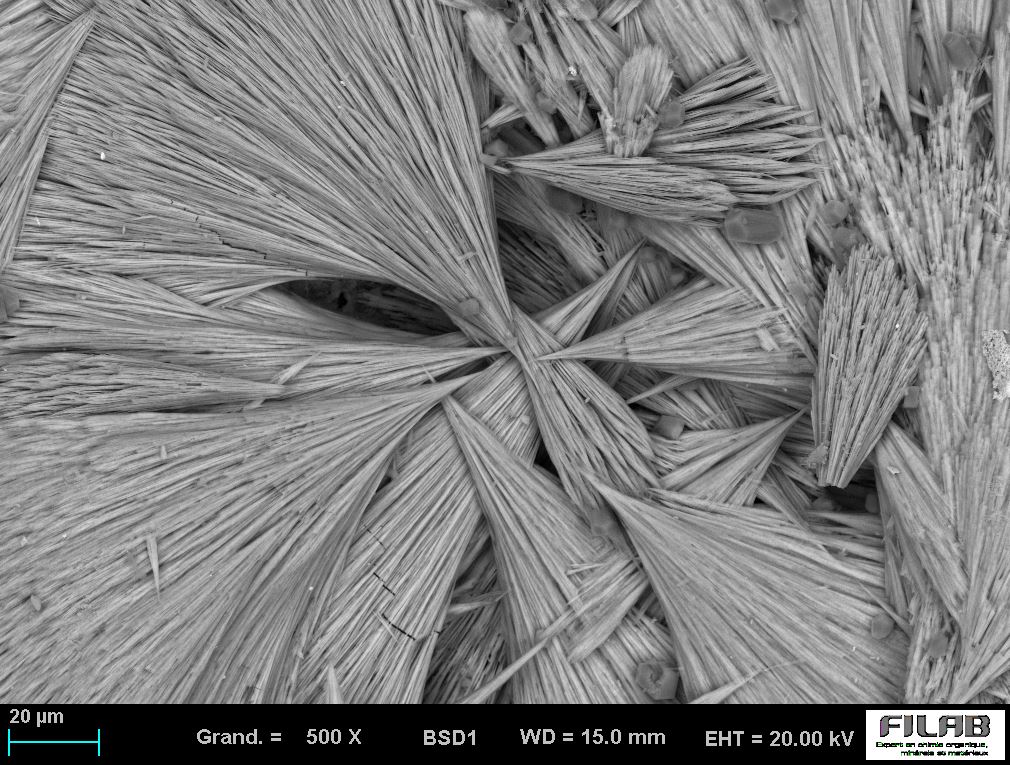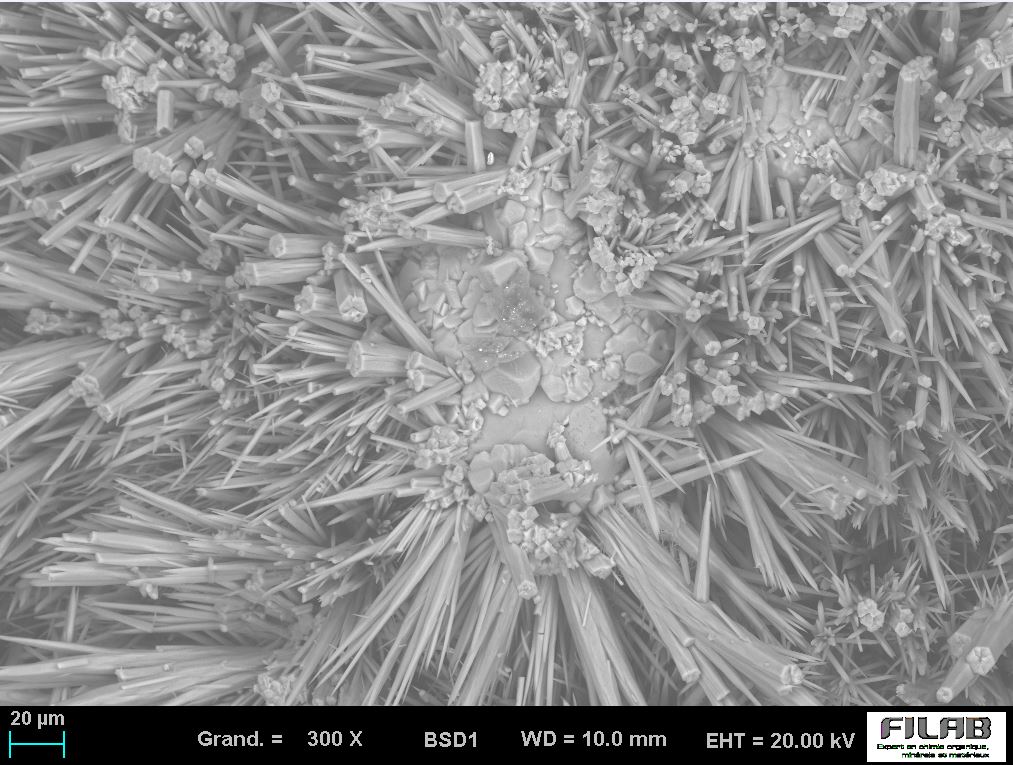Your needs : to determine the root cause of corrosion on your product
What is corrosion ?
Corrosion is the general term used to describe a chemical reaction between a material and its environment leading to the material deteriorating. This phenomenon can affect all kinds of materials but mostly metals and metallic alloys.
Why analyze corrosion problems ?
Corrosion is a veritable industrial scourge, affecting the reliability and strength of a metal product and its structure. The presence of corrosion can also raise health and environmental safety issues.
Understanding corrosion phenomena is a major challenge in the industrial sector. Analysis of corrosion-related failures (leaks, ruptures, adhesion problems, etc.) by a specialist laboratory will help identify the causes external to the material, so that you can adapt your activity with lasting, reliable solutions.
Laboratory analysis of the degree of corrosion attack on a material
Characterising the causes of corrosion in a material
Corrosion resistance test (salt spray tests)
Étudier l'efficacité d'un système anticorrosion appliqué au matériau (traitement de surface, revêtement, peinture, etc.).
Expertise and advice on the choice of an anti-corrosion material or formula to control the lifespan of a product or installation in the face of potential corrosion problems.
Help with your choice of materials for your applications
The study of corrosion experiment plan: from accelerated aging to surface analysis, including the simulation of specific environments (chlorides, extreme pH, inhibiting media).
Study the effectiveness of an anti-corrosion system applied to the material (surface treatment, coating, paint, etc.).
Expertise and advice on the choice of an anti-corrosion material or formula to control the lifespan of a product or installation in the face of potential corrosion problems.
Help with your choice of materials for your applications
Analysis DTRF 150608 (intergranular corrosion test on stainless steel)
NF EN ISO 11846 - 1995 (CIG for aluminium alloys)
ASTM A262-15 (intergranular corrosion test on stainless steel)
ISO 10289 : corrosion test of metallic and inorganic coatings on metallic substrates
Our technical resources for corrosion analysis and assessment
To carry out corrosion analysis on your materials or parts, the FILAB laboratory uses various cutting-edge analysis techniques:


Oxides by SEM
Metals: materials sensitive to corrosion
Metals are widely used for their mechanical and electrical properties, but they are also susceptible to corrosion. Corrosion occurs when metal is exposed to aggressive environments such as moisture, salts and acids. This can lead to a deterioration in the properties of metals.
The study of corrosion makes it possible to maintain the integrity of metals used in industry, in a preventive or corrective manner. Corrosion tests carried out in the laboratory may therefore concern several metals. To find out more, click here:
Comprehensive corrosion testing methods and analytical capabilities at FILAB
FILAB offers both standardized corrosion tests (such as salt spray testing per ISO 9227, electrochemical impedance spectroscopy, or pitting resistance tests) and tailor-made analysis protocols based on your specifications or real-life failures.
Our corrosion laboratory supports material selection, product qualification, and failure investigation by identifying the type, mechanism, and root cause of corrosion.
Corrosion analysis at FILAB includes morphological examination (optical and SEM), elemental analysis (EDS, ICP), and surface chemistry characterization (XPS, Auger). These techniques help determine whether corrosion is due to environmental factors, chemical reactions, galvanic coupling, coating failure, or contamination.
We assist clients across the entire product lifecycle, from raw material evaluation to long-term degradation studies. Our laboratory also supports regulatory compliance, including requirements from FDA, MDR, or automotive quality standards.
The consequences of corrosion on a material
Corrosion can lead to a number of risks and problems for materials, structures and equipment. Below are three major risks associated with corrosion:
To minimise these risks, it is essential to carry out laboratory corrosion analyses in order to prevent corrosion phenomena.
FAQ
A laboratory corrosion study can include different types of materials to be tested. Metals, such as steel, copper and aluminium, are frequently studied because of their frequent exposure to moisture and air. Metal products, such as galvanised steels and copper-nickel alloys, can also be evaluated for their corrosion resistance. Non-metallic materials, such as coatings, plastics and composites, can also be subjected to corrosion tests to assess their durability in the presence of corrosive liquids. In a laboratory corrosion study, various test techniques can be used to mimic real-life conditions. This makes it possible to predict how long a material will last in corrosive environments and to plan accordingly.
To prevent corrosion on steels, the application of protective coatings such as paint, galvanising or plating provides a physical barrier between the steel and corrosive agents. In addition, it is important to maintain a dry environment wherever possible, as humidity is a major factor in corrosion.
Using corrosion-resistant materials in hostile environments and designing structures to allow adequate drainage also help to prevent corrosion. Finally, regular monitoring, preventive maintenance and replacement of corroded parts are essential practices to ensure the durability of steel structures and components.
A corrosion oxidation test is a specific test designed to assess the oxidation and corrosion resistance of a material or coating by exposing the sample to severe environmental conditions. The aim of this test is to simulate the real conditions to which the material will be exposed, in particular when subjected to high temperatures and atmospheric oxygen. Corrosion oxidation testing is commonly used to assess the durability of metallic materials and coatings in exposed environments.
Corrosion is a process that can affect various materials as a result of environmental and chemical factors.
List of the main causes of corrosion on materials:
- Electrochemical corrosion: This is the most common form of corrosion, where electrochemical reactions occur on the metallic material, due to water and ions present in the environment.
- Oxidative corrosion: Metals react with oxygen in the air to form metal oxides, which gradually weaken the material.
- Galvanic corrosion: This occurs when two dissimilar metals come into contact in a conductive environment.
- Pitting corrosion: This is the formation of small holes or pits on the surface of the material, often very localised.
Stress corrosion: This occurs when mechanical stresses are combined with corrosive conditions, which can lead to cracking and material failure. - Microbiological corrosion: Bacteria, fungi and algae can colonise the surface of materials, producing corrosive chemicals.
- Contact corrosion: Exposure to corrosive chemicals such as acids or salts can cause rapid corrosion of materials.
It is important to take these corrosion factors into account when selecting materials and designing your parts, in order to minimise the risks and ensure the durability of components and installations.
Our laboratory's expertise in corrosion analysis can be defined by a number of criteria that demonstrate our ability to provide accurate information on corrosion processes. Here are a few elements to consider when assessing our corrosion expertise:
> Certification and accreditation: FILAB meets high standards of technical competence and testing processes, according to ISO and COFRAC standards.
> Equipment and technology: Expertise in corrosion analysis is based in part on our state-of-the-art equipment and precise measurement technologies.
> Industry experience: FILAB has experience in specific industries, enabling us to carry out tests and analyses for the aerospace, metallurgy, automotive and other industries.
> Multiple services: we offer various corrosion analysis services, such as accelerated corrosion testing, material durability studies, corrosion-related failure analysis, and support for corrosion prevention and protection.
Corrosion testing involves exposing materials to controlled environments to evaluate their resistance to degradation. It helps ensure long-term product safety, performance and compliance, especially in critical sectors such as aerospace, healthcare or oil & gas.
At FILAB, we use a wide range of techniques including salt spray testing (ISO 9227), electrochemical tests, SEM-EDS imaging, and surface spectroscopy (XPS, GD-OES, etc.). These methods allow us to identify corrosion mechanisms and suggest corrective actions.
Yes. Corrosion is a common cause of product failure. Our experts combine visual inspection, surface analysis and chemical testing to identify the origin and nature of the corrosion, enabling effective resolution and prevention strategies.
Absolutely. We analyze corrosion resistance of coatings (organic or metallic), surface passivation, anodization, or multilayer protections. Our lab assesses coating integrity, adhesion loss, delamination, and pitting.
Yes. FILAB is ISO 17025 accredited for several corrosion and surface analysis methods. We deliver reliable, traceable reports suitable for audits and regulatory use.








